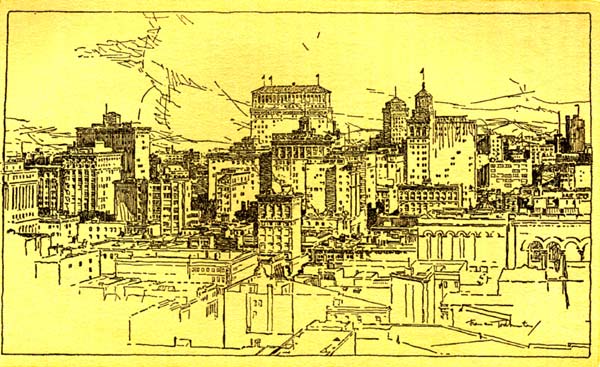| Home -> Other California Books -> Fascinating San Francisco -> Survivals of the Past | |||
|
Survivals of the Past
Stand at the Ferry Building, looking up Market street, and imagine the beginning of the city that spreads before you. First of all you must realize that this point of observation would, in those days, have been offshore, on the shallow water of Yerba Buena Cove. To the right is the scarp of Telegraph Hill, from which ships coming through the Golden Gate were sighted, and to the left is the lesser Rincon Hill, which is being cut away to provide a light manufacturing district. These marked the headlands of the cove, and the waterfront curved inland as far as what is now the site of the Donahue monument to mechanics at Market and Battery streets. Seeking survivals of the past, you must realize that San Francisco is one of the most modern of the comparatively old American cities. Most of the area that saw its beginning and early history has been wiped clean by fire. The San Francisco of today may be said to date from its rebuilding following 1906, since which time something like a half billion dollars' worth of new construction has been done. Yet something of early San Francisco remains, either beyond the reach of the devastation of eighteen years ago or in miraculous islands of safety in that sea of fire. The Presidio, beside the Golden Gate, is several miles from the area that burned. It is one of the largest military posts in the United States, 1,500 acres of forested hills between the inner and the outer harbor. The adobe building in which Rezanov, envoy of the Czar, wooed Senorita Arguello, daughter of the commandante of the Presidio, is preserved in the center of the reservation. You can read about this sad romance in Bret Harte or in Gertrude Atherton. Over the hills southward from the Presidio, in a sheltered valley, where it was spared from the fire, stands Mission Dolores, with its ancient churchyard and headstones. The old mission, whose adobe walls are four feet thick, stands beside a new church of Spanish architecture. Near the entrance to Mission Dolores, set in red tiles on the floor, is a marble slab marking the tomb of the Noe family, Spanish grandees. Interesting relics are in evidence. Early mission bells hang in the facade of the old building. The tomb of Don Luis Arguello, first governor of California under the Mexican regime, is in the churchyard. Inscriptions on many of the stones in this burial place are footnotes to San Francisco's early history. Within the burned area of 1906, above the original waterfront of the days when the water came up to Montgomery street, there are several blocks of buildings which were spared by freaks of fate. These buildings stand near the original Plaza now called Portsmouth Square. It was here Commodore John Montgomery landed from the "Portsmouth" and raised the Stars and Stripes on July 4, 1846, almost the seventieth anniversary of the establishment of the Spanish Presidio. The site of his landing, at what is now Clay and Montgomery streets, has been marked by one of the bronze tablets on which the order of the Native Sons of the Golden West has graven many of the historic episodes of California. Not far away, on the south side of Sacramento street, between Davis and Front, there is a brick building marked by a tablet as the site of Fort Gunnybags, headquarters of the Vigilance Committee, which in 1856 hanged Casey and Cora, two enemies of law and order, from its windows. In Portsmouth Square itself, token of a gentler spirit, there stands a drinking fountain in memory of Robert Louis Stevenson. That prince of idlers and of prose spent many an hour on the sunny benches of this square. The streets nearby, where stand the few buildings that escaped the fire, echo the footsteps of Stevenson, of Mark Twain and Bret Harte. The Hall of justice faces the square. The Parrott building, erected in 1853 by Chinese labor with stone brought from China, remains standing at California and Montgomery streets. Around the Plaza centered the life of the pueblo and of the early city of San Francisco, but now on three sides of it is Chinatown, the fashionable homes having long been gone from this section. In Golden Gate Park, beside a lake reflecting their outline, stand marble columns that once flanked a doorway on Nob Hill, which rises above the Oriental quarter. This relic has been named "Portal of the Past." It symbolizes the old San Francisco that is gone save for a few traces, for this is, after all, a new city. It is in the San Francisco of today, with a historic background that survives in spirit instead of in material reminders, that interest is dominant. |
|||
 |
|||
|
The City That Is
Citadels of modern business raised on the ashes of the City That Was |
|||